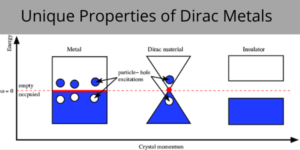What are the Unique Properties of Dirac Metals?
All About Dirac & Semi- Dirac Metals, their unique properties, and basic concept
A special property in the class of materials has been discovered by the researchers from IIT Bombay, called “semi-Dirac metals”.
These materials would be transparent to light of a given frequency and polarisation when it is incident along a particular direction. The material would be opaque to the same light when it falls on it from a different direction.
Read more: Important International Organizations
Read more: Banking in India- Important Highlights of Banking Sector in India

Now, the question arises that What are Dirac metals?
As we know that the quality of conduction in normal metals like gold and silver depends on the way energy depends on the momentum of electrons. So, in Dirac metals, the properties differ from normal metals as in that the energy depends linearly on the momentum.
This difference here is responsible for their unique properties. Many times, Semi-Dirac metals behave like Dirac metals in one direction and like normal metals in the perpendicular directions.
The uniqueness about semi- Dirac metals-
- Within any material, charge carriers, such as electrons, acquire an effective mass which is different from their bare mass depending on the nature of the material.
- The effective mass and the number of states available for the electron to occupy when it is excited by an electric field, determine the conductivity and other such properties.
- In particular, the effective mass becomes zero for conduction along with a special direction.
Examples of semi-Dirac metals are systems such as TiO2/V2O3 nanostructures. There are many known applications for transparent conducting films – the common example being touch screens used in mobiles.
Recent Significance-
The energy-momentum dispersion relation can be linear, leading to large velocities and vanishingly small effective masses. The velocities can be over 100 times more than normal metals, thus increasing the mobility and currents that can be carried across devices that are made of these so-called Dirac materials. In the semi-Dirac metals, these properties are direction-dependent. The direction-dependence of the microscopical properties gives the material special optical properties.
For more such informative articles stay tuned to OWN TV.
